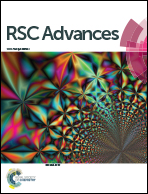Air-stable PbS quantum dots synthesized with slow reaction kinetics via a PbBr2 precursor
Abstract
PbS quantum dots have been synthesized using a PbBr2 precursor and the halide content has been examined. Slower reaction kinetics for quantum dots growth relative to the use of PbCl2 was observed for PbBr2, giving a possible route to increased control over quantum dot size with in situ passivation. Unambiguous determination of the surface conditions of nanomaterials is still a developing area of science, pushing the limits of current microscopy and analytical techniques. Contributions to a rigorous form of nanomaterial surface analysis are made here using X-ray photoelectron spectroscopy to analyse bonding in detail. Atomic resolution TEM is applied to produce energy dispersive X-ray spectroscopy maps with state of the art resolution. This analysis has been applied to air-stable halide terminated PbS nanoparticles, which is a nanomaterial of central importance for quantum confined solar cell applications. Chemical analysis from X-ray photoelectron spectroscopy is consistent with Br surface termination and high resolution energy dispersive X-ray spectroscopy (EDS) maps also show a positive spatial correlation for Br with quantum dot location. An observed excess Br content is attributed to the presence of bromine terminated PbS quantum dots nuclei in the final colloid.


 Please wait while we load your content...
Please wait while we load your content...